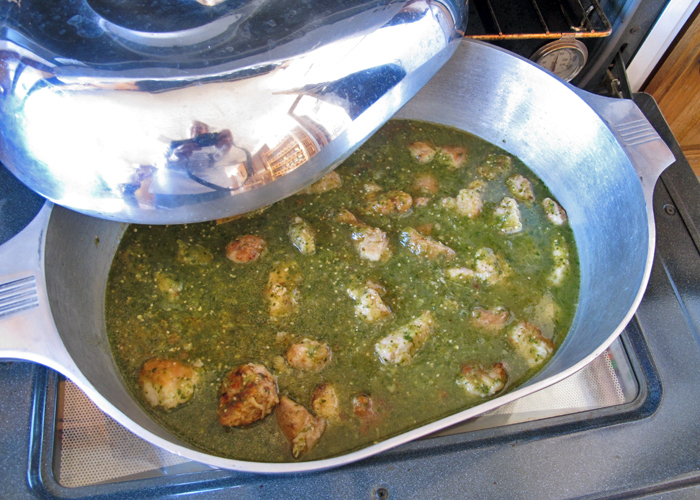Carne de Cerdo en Salsa Verde (Pork in Green Chile Sauce)
 Salsa verde (Green sauce)
Salsa verde (Green sauce)
1 pound tomatillos (known in Mexico as tomate verde), husks removed
4 or 5 whole chiles serrano, depending on your tolerance for picante (spiciness)
1/2 medium white onion, coarsely chopped
1 clove garlic (optional)
1 medium bunch fresh cilantro, largest stems removed
Sea salt to taste
1 kilo (2.2 pounds) very lean fresh pork butt, cut into 2″ cubes
White flour
Salt
Oil or lard sufficient for frying the pork
In a large pot of water over high heat, bring the tomatillos and chiles (and garlic, if you choose to use it) to a full rolling boil. Boil just until the tomatillos begin to crack; watch them closely or they will disintegrate in the water. Let the tomatillos and chiles (and garlic, if you like) boil until the tomatillos begin to crack. Using a slotted spoon, scoop the cooked tomatillos, salt, and chiles into your blender jar. There’s no need to add liquid at first, but reserve the liquid in which the vegetables boiled until you see the thickness of your sauce. You might want to thin it slightly and the cooking liquid will not dilute the flavor. Set the vegetables aside to cool for about half an hour. Once they are cool, cover the blender, hold the blender cap on, and blend all the vegetables, including the chopped onion, until you have a smooth sauce. Be careful to allow the tomatillos and chiles to cool before you blend them; blending them while they are fresh from the boiling water could easily cause you to burn yourself, the hot mixture tends to react like molten lava in the blender. (Note: don’t ask me how I know this.) In the blender, the boiled and cooled tomatillos and chiles. The cilantro goes in last. While the blender is running, remove the center of its cap and, little by little, push the cilantro into the whizzing sauce. Blend just until smooth; you should still see big flecks of dark green cilantro in the lighter green sauce. Test the salt and correct if necessary. Reserve the sauce for later use.
Pat the 2″ pork cubes as dry as possible with paper towels. Put about 1/4 cup flour in a plastic grocery-size bag. Add 1/2 tsp salt. Melt the lard over high heat in a large heavy oven-proof casserole. While the lard is melting, shake about 1/4 of the cubed pork in the salted flour. When the oil or lard begins to smoke, add the floured pork cubes, being careful not to dump the flour into the pan. Cover the pan. As the pork cubes brown, shake another 1/4 of the pork cubes in flour and salt. Turn the pork cubes until all sides are golden brown. Remove browned cubes to a bowl and reserve. Add more floured pork to the hot lard. You may need more oil or lard as well as more salted flour. Repeat until all pork cubes are well browned. Reserve the browned pork in the same pan, scraping the crispy bits from the bottom. Most Mexican housewives do not flour and brown the pork cubes prior to cooking them in the sauce. I like to prepare the dish this way because the browned flour adds a deeper flavor to the finished sauce. Everyone taste is different, though, and you are of course welcome to tweak the recipe till the finished product is just the way you like it. Add the sauce to the pork cubes in the casserole, making sure that all the cubes are immersed in sauce. Cover and put the casserole into the oven, reducing the heat to 160°C or 325°F. Bake for two hours. Add cooking liquid from the vegetables if necessary to keep the sauce relatively thick but not sticking to the casserole. The pork will be fork-tender and the green sauce will take on a rich, deep, pork-y flavor and color. Serve with arroz blanco (steamed white rice) or arroz a la mexicana (red rice), refried beans, a colorful, contrasting vegetable, and fresh, hot tortillas. Mexico Cooks!’ money-back guarantee: everyone will come back for seconds.